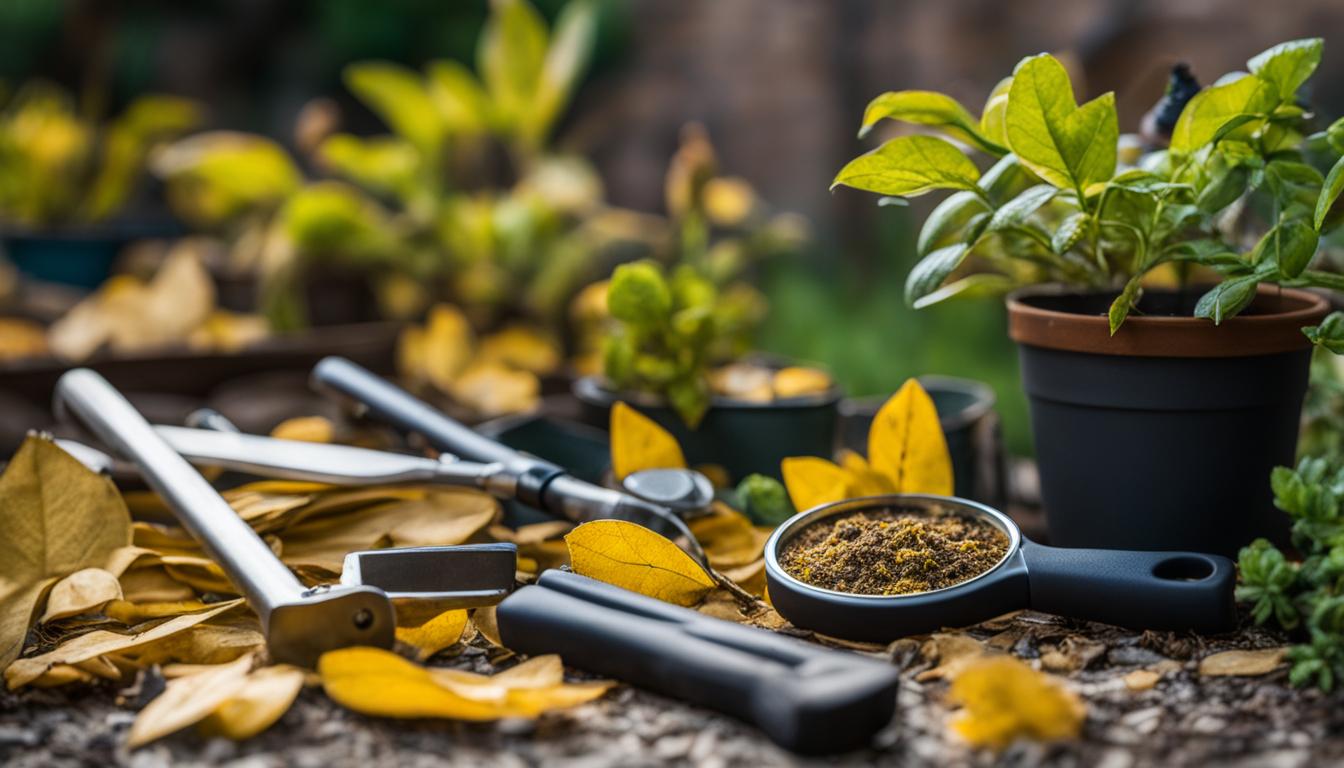Hello, plant enthusiasts! Have you ever wondered why your plant’s leaves turn yellow? It can be quite a mystery, but fear not! I’m here to help you troubleshoot and solve the common plant problems causing those yellow leaves.
Yellowing leaves on plants are a sign that something isn’t quite right with their health. By understanding the underlying causes of yellow leaves, you can take the necessary steps to address and resolve these issues. Let’s dive into the world of plant health problems and find solutions together!
Key Takeaways:
- Yellow leaves on plants are a symptom of various problems.
- Overwatering or underwatering can lead to yellow leaves.
- Inadequate light can cause leaf yellowing.
- Nutrient deficiencies, such as nitrogen or iron, can result in yellow leaves.
- Temperature stress and pest infestations can also cause yellowing leaves.
Overwatering and Underwatering
One common cause of yellow leaves is overwatering or underwatering. Both of these watering practices can have detrimental effects on a plant’s health and lead to yellowing leaves.
Overwatering Plants
Overwatering occurs when plants receive more water than they need. This excessive water can lead to root rot, a condition where the roots become waterlogged and start to decay. As a result, the roots are unable to absorb nutrients properly, leading to nutrient deficiencies. The lack of oxygen in the soil also affects root function, further contributing to yellow leaves.
It’s important to establish a proper watering schedule based on the specific needs of each plant. Factors such as the plant species, pot size, and environmental conditions should be considered. Checking the moisture level of the soil using a finger or a moisture meter can help determine whether watering is necessary.
Underwatering Plants
Underwatering, on the other hand, occurs when plants do not receive sufficient water to meet their needs. This can happen due to infrequent watering or inadequate amounts of water provided. When a plant is underwatered, it becomes dehydrated, and the lack of water impairs its ability to carry out essential functions like nutrient absorption. This can result in nutrient deficiencies and, consequently, yellowing leaves.
To prevent underwatering, it’s crucial to monitor the soil moisture consistently and water plants when the top inch of soil feels dry. Adjusting the watering frequency and amount based on the plant’s requirements can help maintain proper hydration levels.
| Signs of Overwatering | Signs of Underwatering |
|---|---|
| – Yellowing leaves | – Yellowing leaves |
| – Wilting | – Wilting |
| – Mushy or rotting roots | – Dry and sparse soil |
| – Foul smell from the soil | – Crispy or brittle leaves |
By understanding the importance of proper watering techniques and the impact of overwatering and underwatering, you can prevent yellowing leaves caused by root-related issues. Providing the right amount of water ensures that plants can absorb nutrients effectively and maintain optimal health.
Insufficient Light
Plants require a certain amount of light to thrive. If a plant is not receiving enough light, its leaves may turn yellow. Inadequate light can hinder the process of photosynthesis, which is essential for the plant’s energy production and overall health.
When it comes to low light plants, it’s crucial to understand their specific lighting needs. Some plants are more tolerant of lower light conditions, while others require bright, indirect light to flourish. Assessing the light requirements of your plants will help you provide the optimal conditions for their growth.
If you notice yellowing leaves on your plant, adjusting the lighting is a great place to start. Move the plant closer to a brighter window or consider supplementing with artificial grow lights. However, be cautious of providing direct sunlight, as it can potentially burn the leaves and cause damage. Striking a balance between adequate light and avoiding excessive exposure is key.
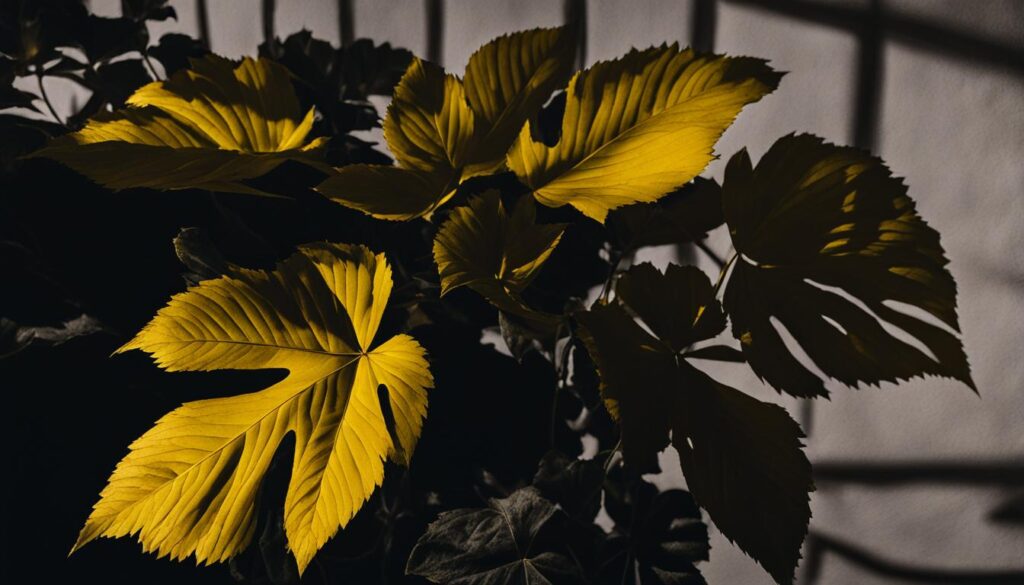
Creating a suitable environment for your plants involves finding the right balance of light, temperature, and humidity. By adjusting the lighting to meet the needs of your low light plants, you can promote healthy leaf growth and prevent yellowing.
Adjusting Lighting for Different Plant Species
It’s important to note that every plant has specific light requirements. Here are a few examples of popular houseplants and their preferred lighting conditions:
- Pothos: Pothos plants are low light plants that can tolerate a variety of lighting conditions. They prefer bright, indirect light but can also thrive in low light areas.
- Snake Plant: Snake plants are extremely resilient and can tolerate low light conditions. They can survive in both bright and dimly lit rooms.
- Peace Lily: Peace lilies thrive in medium to bright indirect light. Placing them near a window with filtered light is ideal.
Remember to research the specific lighting needs of your plants to ensure they receive adequate light for optimal growth.
Nutrient Deficiencies
When it comes to yellowing leaves, nutrient deficiencies can often be the culprit. Lack of essential nutrients such as nitrogen, phosphorus, potassium, or iron can result in leaf discoloration and hinder plant health.
These vital nutrients play pivotal roles in various physiological processes, including photosynthesis and the production of healthy leaves. Let’s take a closer look at each of these nutrient deficiencies and their effects on plants:
Nitrogen Deficiency
Nitrogen is a key component for the synthesis of chlorophyll, the pigment responsible for the green color of leaves. A lack of nitrogen can lead to pale or yellowish leaves, stunted growth, and reduced overall plant vigor.
Phosphorus Deficiency
Phosphorus is essential for energy transfer and root development in plants. When phosphorus levels are low, plants may exhibit yellowing leaves, particularly on older foliage. The leaves may also become dark green or bluish-green.
Potassium Deficiency
Potassium promotes overall plant health, enhances disease resistance, and plays a vital role in enzyme activation. When plants lack potassium, they may display yellowing or browning along the leaf margins and between the veins. The leaves may also appear scorched or have a burnt appearance.
Iron Deficiency
Iron is a micronutrient necessary for chlorophyll production and photosynthesis. Without sufficient iron, plants may develop interveinal chlorosis, where the areas between the veins turn yellow while the veins remain green. This condition is commonly observed in acid-loving plants.
It is important to note that different plants have varying nutrient requirements, and the symptoms of nutrient deficiencies may manifest differently in different species. Conducting a soil test and consulting with a plant expert can help determine the precise nutrient needs of specific plants and guide appropriate nutrient supplementation.
Next, let’s explore the effects of temperature stress on plants and how it can contribute to yellowing leaves.
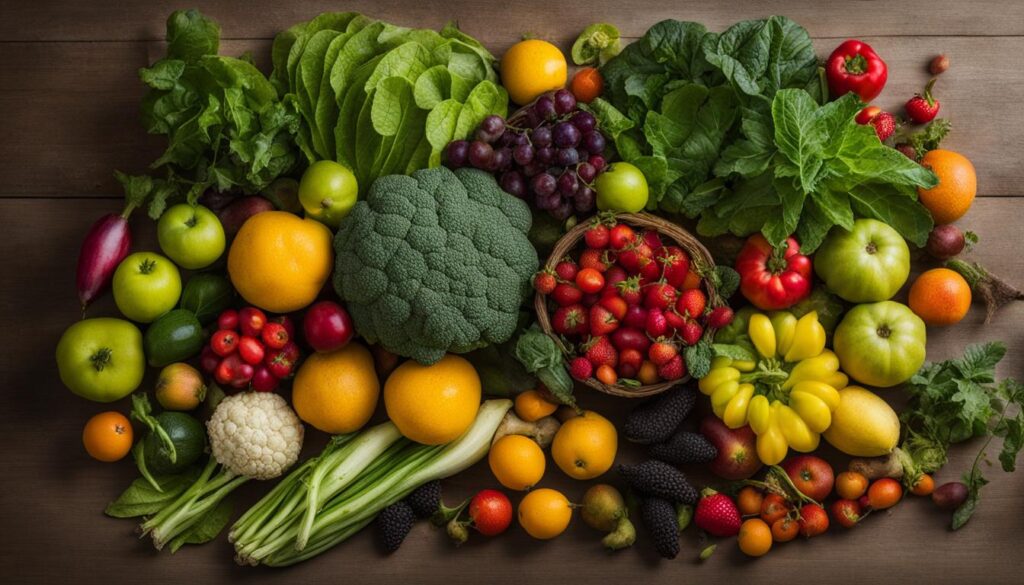
Temperature Stress
Fluctuating temperatures, especially during cold weather, can cause stress on plants, leading to yellowing leaves. It’s important to move plants away from drafts and maintain a consistent temperature to prevent plant stress.
Extreme cold or sudden temperature fluctuations can disrupt a plant’s metabolism, affecting its ability to absorb nutrients and water. This can result in yellowing leaves as the plant struggles to adapt to the unfavorable conditions.
To protect your plants from temperature stress, here are some tips:
- Avoid placing plants near windows or doors that are frequently opened and closed, as drafts can expose them to rapid temperature changes.
- If your plants are in containers, consider moving them indoors during cold weather or providing them with additional insulation.
- Use a thermometer to monitor the temperature around your plants. If the temperature drops below the recommended range for a particular plant, take measures to protect it, such as covering it with a frost cloth.
- Provide additional warmth to your plants by using a heating mat or placing them near a heat source like a radiator (with caution) to maintain a stable temperature.
By taking these precautions and creating a stable environment for your plants, you can minimize temperature-related stress and help prevent yellowing leaves.
Pest Infestations
Pests on plants can cause significant damage, leading to various issues such as yellowing leaves, stunted growth, and even plant death. Two common pests that often infest plants are spider mites and aphids.
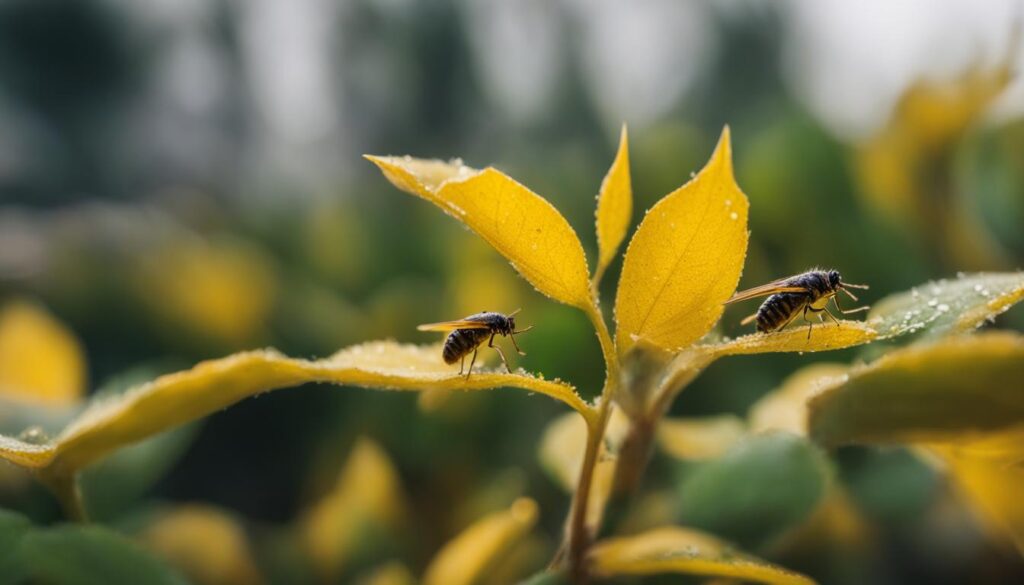
Spider Mites
Spider mites are tiny pests that can wreak havoc on plants. They feed on the sap of the leaves, causing yellow spots and discoloration. As their population grows, the damage becomes more severe, and the leaves may turn completely yellow.
Spider mites thrive in warm and dry conditions, making them a common problem for indoor plants. To get rid of spider mites, you can try spraying the affected plants with a mixture of water and mild soap. Alternatively, you can introduce natural predators like ladybugs or use specialized insecticides.
Aphids
Aphids are another type of common plant pest that can cause yellow spots on leaves. These small insects also feed on the sap, leading to stunted growth and weakened plants. Aphids reproduce quickly, so it’s crucial to address an infestation promptly.
There are multiple ways to control aphids on plants. One effective method is to spray the affected plants with a mixture of water and dish soap. You can also introduce beneficial insects like lacewings or use organic insecticides that specifically target aphids.
Other Pest-Related Issues
Pests can introduce fungal or bacterial infections into plants, which can further contribute to yellow spots or overall yellowing of leaves. These infections weaken the plant’s immune system and impact its overall health.
To minimize the risk of pests and associated infections, it’s essential to practice good plant hygiene. Regularly inspect your plants for signs of pests, such as distorted leaves or small insects. Remove any affected leaves or plants to prevent the spread of pests and their potential damage.
In cases of severe pest infestations, it may be necessary to consult a professional gardener or horticulturist for further guidance and treatment options.
Diagnosing Plant Issues
When it comes to the perplexing problem of yellow leaves, a proper diagnosis is essential. Yellow leaves can be an indication of various plant health issues, and identifying the underlying cause is crucial for effective troubleshooting. Let’s explore some common problems and methods for diagnosing plant issues:
1. Visual Examination
Begin by closely inspecting the affected plant. Look for any signs of pests, discoloration, or visible damage. Examine the leaves, stems, and roots for abnormalities such as spots, lesions, or rot.
2. Symptom Analysis
Take note of the specific symptoms that accompany the yellowing leaves. Are there any patterns or specific areas where the yellowing is most prominent? Look for additional signs such as leaf curling, wilting, or stunted growth.
3. Comparison with Plant Troubleshooting Guide
Consult a reliable plant troubleshooting guide or resource to compare the observed symptoms with common plant diseases and deficiencies. Look for matching patterns, descriptions, and visual representations that align with your plant’s condition.
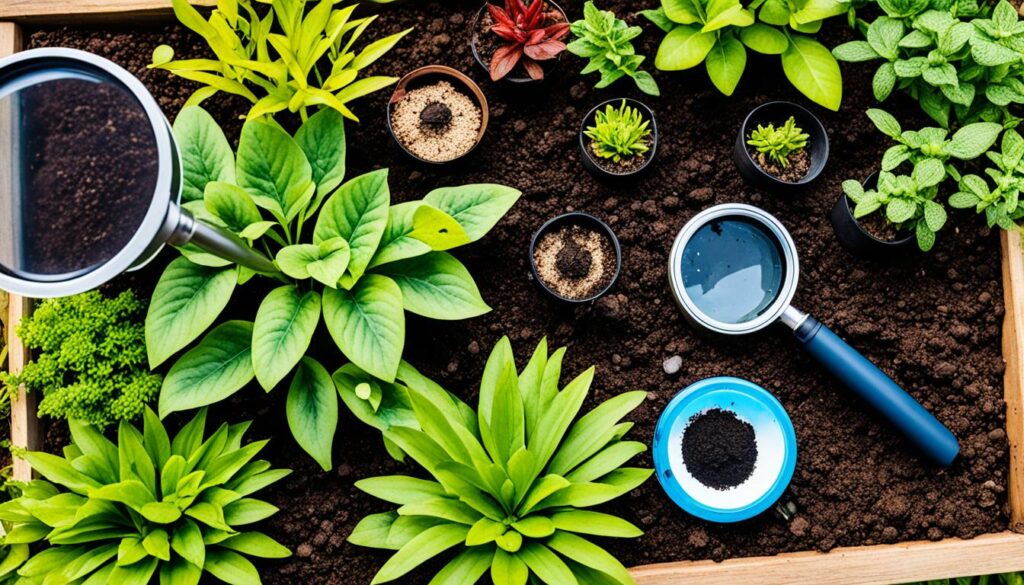
4. Laboratory Testing
If the cause of yellow leaves remains unclear, consider sending a sample to a reputable plant diagnostic laboratory for further analysis. They can conduct tests to identify specific pathogens, nutrient deficiencies, or other factors contributing to the plant’s poor health.
5. Seeking Expert Advice
If you’re unable to identify the problem on your own or require professional guidance, reach out to local horticulturalists, extension offices, or experienced gardeners in your area. They can provide valuable insights and recommendations based on their expertise.
6. Documenting Observations
Throughout the diagnosis process, make sure to document your observations. Take clear pictures, write down relevant details, and keep track of any changes or developments in the plant’s condition. This information will be helpful when discussing the issue with experts or researching further.
7. Considering Environmental Factors
Remember that environmental factors, such as extreme temperatures, improper watering, or exposure to chemicals, can also contribute to yellowing leaves. Take into account the plant’s surroundings and any recent changes that could be impacting its health.
By following this plant troubleshooting guide and utilizing various diagnostic methods, you can pinpoint the specific issue causing yellow leaves and take appropriate action to restore your plant’s vitality.
Adjusting Care Practices
Once the cause of yellow leaves is identified, I can make adjustments to my plant care practices to restore their health and vibrant greenery. It’s important to address key factors such as the watering schedule, lighting, and nutrient supplementation.
Modifying the Watering Schedule
Proper watering is crucial for plant health. If overwatering or underwatering is the culprit behind the yellow leaves, I need to adjust the watering schedule accordingly. To avoid overwatering, I will let the top inch of the soil dry out before watering again. Conversely, if dehydration is the issue, I will water my plants more frequently, ensuring the soil remains consistently moist.
Providing Adequate Lighting
Light is an essential element for photosynthesis and the overall well-being of plants. If inadequate lighting is causing yellow leaves, I will move my plants to a brighter location or invest in grow lights. It’s important to find the right balance, providing enough light without exposing the plants to direct sunlight, which can lead to leaf burn.
Supplementing Nutrients
When nutrient deficiencies are contributing to yellow leaves, I can supplement my plants’ diet with the necessary nutrients. Depending on the specific deficiency, I can use organic fertilizers or foliar sprays to provide an extra boost. It’s important to follow the instructions and dosage recommendations provided by the manufacturer.
I will adjust my care practices by modifying the watering schedule, providing adequate lighting, and supplementing nutrients to address the specific issues causing yellow leaves. By consistently implementing these adjustments, I can restore my plants’ health and promote lush, vibrant foliage.
| Adjustment | Benefits |
|---|---|
| Modifying watering schedule | – Prevents overwatering or dehydration – Restores proper moisture balance – Promotes healthy root development |
| Providing adequate lighting | – Enhances photosynthesis – Encourages vibrant foliage – Minimizes leaf burn risk |
| Supplementing nutrients | – Addresses nutrient deficiencies – Supports healthy leaf production – Boosts overall plant vigor |
Removing Yellow Leaves
In some cases, yellow leaves may need to be removed to redirect the plant’s energy towards healthier growth. Cutting off yellow leaves allows the plant to focus on maintaining the still-green leaves thriving. This promotes overall plant health.
Tips for Restoring Healthy Greenery
If your plants are suffering from yellow leaves, restoring healthy greenery requires a multi-faceted approach. By accurately identifying the cause of the yellowing, making adjustments to your plant care practices, and providing the necessary nutrients and optimal growing conditions, your plants can regain their vibrancy and vitality. Here are some tips to help you restore healthy plants:
- Determine the Cause: The first step in restoring healthy greenery is to determine the underlying cause of the yellow leaves. Refer to the previous sections of this guide to troubleshoot common plant issues such as overwatering, insufficient light, nutrient deficiencies, temperature stress, or pest infestations.
- Adjust Care Practices: Once you have identified the cause, adjust your care practices accordingly. This may include modifying your watering schedule, providing adequate light, adjusting the temperature, or implementing pest control measures. Each plant species has different care requirements, so make sure to research the specific needs of your plants.
- Provide Necessary Nutrients: Nutrient deficiencies can contribute to yellowing leaves. To restore healthy greenery, consider using a balanced fertilizer or plant supplement that provides the necessary nutrients for optimal growth. Follow the manufacturer’s instructions for application rates and frequencies.
- Optimize Growing Conditions: Ensure your plants are in the optimal growing conditions. This includes providing the appropriate temperature, humidity, and airflow for your plant species. Additionally, consider repotting your plants in fresh, well-draining soil to promote healthy root growth.
“Restoring healthy greenery in plants requires a comprehensive approach that addresses the underlying issues responsible for yellow leaves.”
By following these tips and giving your plants the care they need, you can restore healthy greenery and enjoy lush, vibrant plants once again.
Example of Optimized Growing Conditions for Different Plant Types
| Plant Type | Optimal Temperature Range | Optimal Light Conditions | Optimal Humidity Levels |
|---|---|---|---|
| Succulents and Cacti | 65°F – 80°F (18°C – 27°C) | Bright, direct sunlight | Low to moderate humidity |
| Leafy Green Houseplants | 60°F – 75°F (15°C – 24°C) | Bright, indirect sunlight | Medium to high humidity |
| Orchids | 70°F – 85°F (21°C – 29°C) | Bright, indirect sunlight | High humidity |
| Herbs | 60°F – 75°F (15°C – 24°C) | Bright, direct sunlight | Medium humidity |
Conclusion
When it comes to yellow leaves on plants, it’s important not to panic. Instead, take a methodical approach to diagnosing the problem and implementing the necessary solutions. By understanding the common causes of yellow leaves and following proper plant care tips, you can restore your plants to their vibrant greenery.
Diagnosing plant problems begins with identifying the specific cause of leaf discoloration. It could be due to overwatering or underwatering, insufficient light, nutrient deficiencies, temperature stress, or pest infestations. Each issue requires a targeted solution to address the underlying problem.
By adjusting your care practices, such as modifying the watering schedule, providing adequate light, and supplementing nutrients, you can prevent and treat yellow leaves effectively. Remember to remove yellow leaves when necessary to redirect the plant’s energy towards healthy growth.
FAQ
What are the common causes of yellow leaves on plants?
Common causes of yellow leaves include overwatering or underwatering, insufficient light, nutrient deficiencies, temperature stress, pest infestations, and plant diseases.
How does overwatering or underwatering affect plant health?
Overwatering can lead to root rot and suffocate the plant’s roots, while underwatering can cause dehydration and nutrient deficiencies.
Why do plants develop yellow leaves due to insufficient light?
Plants require a certain amount of light for photosynthesis. If a plant is not receiving enough light, its leaves may turn yellow.
What are nutrient deficiencies and how do they cause yellow leaves?
Nutrient deficiencies, such as lack of nitrogen, phosphorus, potassium, or iron, can lead to yellowing leaves. These essential nutrients are crucial for photosynthesis and leaf production.
How does temperature stress affect plant health?
Fluctuating temperatures, especially during cold weather, can cause stress on plants, leading to yellowing leaves. It’s important to maintain a consistent temperature to prevent plant stress.
How do pests infestations contribute to yellowing leaves?
Pests like spider mites and aphids can infest plants, sucking their sap and causing yellowing leaves. Fungal or bacterial infections can also result in yellow spots or overall yellowing of leaves.
How can I diagnose plant problems associated with yellow leaves?
Diagnosing plant issues involves observing other symptoms, inspecting the plant for pests or diseases, and considering environmental factors like watering and light conditions.
What adjustments can I make to my plant care practices to address yellow leaves?
Adjustments may include modifying the watering schedule, providing adequate light, and supplementing nutrients to restore plant health.
Should I remove yellow leaves from my plants?
In some cases, removing yellow leaves directs the plant’s energy towards healthier growth. It promotes overall plant health.
What are some tips for restoring healthy greenery in plants with yellow leaves?
Restoring healthy greenery involves identifying the underlying issue, adjusting care practices, and providing necessary nutrients and conditions for optimal growth.
How can I solve the mystery of yellow leaves on my plants?
By understanding common causes like overwatering, insufficient light, nutrient deficiencies, temperature stress, pest infestations, and plant diseases, you can troubleshoot and address these plant health issues effectively.
Source Links
- https://www.realsimple.com/why-your-plant-leaves-are-turning-yellow-and-how-you-can-fix-it-7547557
- https://tumbleweedplants.com/blogs/plant-blog/solve-the-mystery-of-yellow-leaves-on-your-indoor-plants-tips-to-restore-vibrant-greenery
- https://www.architecturaldigest.com/story/yellow-leaves-on-plants-guide

